Ravencoin Halving Countdown
Time remaining until Ravencoin block rewards will be cut in half:
🎁 Cash Out Crypto to Any Bank Account With Ogvio. Best Rates. Instant Transfers. Start Now !
Ravencoin
RVN| Halving | Est. Halving Date | Block | Block Reward |
|---|---|---|---|
| #1 | January 11, 2022 | 2,100,000 | 2500 RVN |
| #2 | Beginning of 2026 | 4,200,000 | 1250 RVN |
| #3 | Beginning of 2030 | 6,300,000 | 625 RVN |
Market Cap
$123,952,669
Circulating Supply
16,022,398,307 RVN
Max Supply
21,000,000,000 RVN
Current Block
4,233,279
Current Block Reward
2500 RVN
Block Reward After Halving
1250 RVN
Interested in learning more about the Ravencoin halving? Or, perhaps you’re simply curious about the RVN halving date calculator? Well, you’ve come to the right place!
When is the Next Ravencoin Halving?
The next Ravencoin halving date is estimated to occur at the beginning of 2026.
When Will the Last Ravencoin Halving Happen?
The very last Ravencoin halving will happen when the rewards for mining a block cannot be halved anymore. This is set to be in the very distant future.
What is the Ravencoin Halving History?
As of writing this, there has only been a single RVN halving event. It happened on January 11, 2022.
What is Ravencoin Halving?
Ravencoin halving is a process where, once every 4 years or so, the mining rewards for the RVN token are halved.
As a definition, that sounds pretty self-explanatory. However, as with most other things-crypto, there are many more details beneath the surface. In order to understand how Ravencoin halvings work, you first need to know about the intricacies surrounding the project – specifically, mining RVN tokens.
Ravencoin, Bitcoin, and Proof-of-Work
Ravencoin was founded in 2018 - it’s considered one of the newer crypto projects around, compared to staple networks such as Bitcoin and Ethereum. In fact, the blockchain project in question is actually pretty similar to the industry titans mentioned above.
That statement might sound a bit odd if you’re familiar with both of those industry-leading networks, as they are quite a bit different from one another. That said, allow me to explain how Ravencoin fits in.
As a standalone project, Ravencoin is similar to Ethereum. Setting aside any RVN halvings or some other token-specific features, Ravencoin’s purpose is to facilitate token issuance and retain real-world value by offering tangible asset representations, community-governed tokenomics, and so on.
Ethereum is somewhat similar in regards to the token issuance question. That said, while both crypto projects offer things such as NFT support, Ethereum is still the leader in the DeFi space, solely because it was the network where most decentralized finance projects were born in the first place.
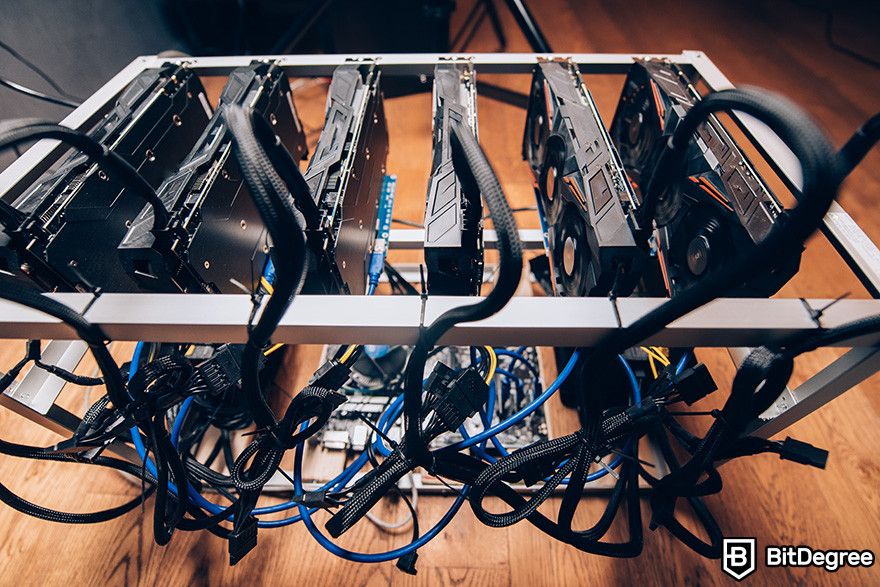
All of that being said, as far as the Ravencoin halving dates are concerned, this is where RVN is similar to Bitcoin. It makes sense - Ravencoin was actually a fork of the Bitcoin network, to begin with!
This also means that both Ravencoin and Bitcoin are Proof-of-Work blockchains. In other words, they both utilize cryptocurrency mining mechanics and count on miners in order to keep the processes happening on the blockchain safe and legitimate (verified).
The Proof-of-Work concept here is actually quite essential. It’s the cornerstone behind both Ravencoin halving, as well as most other crypto halving events that happen, with a few exceptions (i.e., Ethereum Triple Halving).
However, the one big difference between Ravencoin and Bitcoin is the fact that the former crypto asset is ASIC-resistant, while the latter is not. Granted, it’s a bit of a complex concept to get into. So, allow me to explain in more detail.
ASICs are special devices that are used to mine PoW cryptocurrencies. They are quite popular thanks to their efficiency - if you’re serious about crypto mining, ASICs will usually be the way to go… With most cryptocurrencies, that is.
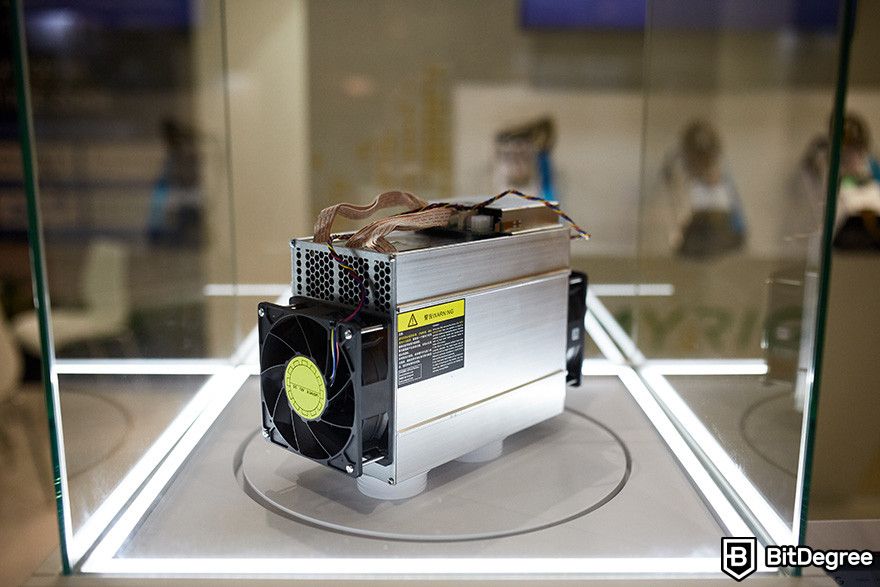
Some specific projects, however, are ASIC-resistant - meaning that they do not allow the use of ASIC devices to mine their native tokens. Learning about Ravencoin halvings, you should be aware that this network is just like that.
The key question here is why. Why does Ravencoin essentially ban ASICs? Well, it’s pretty simple, really - it's all because of your common, everyday GPU miner.
If you were to mine crypto on your personal computer, you could never compete with someone else who’s mining the same cryptocurrency with their ASIC device. This results in much smaller profits for GPU miners and, to an extent, much more centralization. The development team behind Ravencoin wanted to avoid this potential issue altogether.
What does all of this have to do with RVN halving countdowns and dates, you might ask? In actuality, understanding how Ravencoin works is essential in seeing the bigger picture!
How Does Ravencoin Halving Work?
Simply put, Ravencoin halving is very similar to that of Bitcoin. Both halving events happen around every 4 years or so, and they both “do the same thing” - halve the rewards that miners receive from mining a block on the network (confirming transactions and keeping the entire blockchain secure).
The big difference, however, lies in numbers. While both halvings happen approximately every 4 years, the two blockchain projects in question are still very different, and thus, the numbers differ as well. Take a look for yourself:
- Bitcoin has a total supply of 21 million, while Ravencoin has 21 billion;
- Bitcoin’s current block mining reward is 6.25 BTC, while Ravencoin’s is 2500 RVN;
- It takes around 10 minutes to mine a BTC block, while it only takes about 1 minute to mine that of RVN;
- Bitcoin halving happens every 210,000 blocks, while Ravencoin halving occurs every 2,100,000 blocks.
The math checks out! While the Ravencoin network has a hard cap 1,000 times bigger than that of Bitcoin, its block mining time is also 10 times smaller. On top of that, the Ravencoin halving takes 10 times as many blocks to occur as it does for Bitcoin.
The result? A very similar amount of time for both blockchains to participate in their own halving events.
The key numbers that I’m yet to talk about are the block mining rewards. Similar as with BTC or any other “traditional” halving-employing cryptocurrency on the market, Ravencoin cuts its mining rewards in half whenever the halving happens.
As of writing this Ravencoin halving countdown text, there has only been a single RVN halving so far. It took place on January 11, 2022. Assuming that all halvings will happen every 4 years, this is what the halving schedule is estimated to look like:
| Date | Block Height | Block Reward |
|---|---|---|
| January 11, 2022 | 2,100,000 | 2,500 RVN |
| Est. early 2026 | 4,200,000 | 1,250 RVN |
| Est. early 2030 | 6,300,000 | 625 RVN |
| ... | ... | ... |
| ? | ? | ? |
Table: Ravencoin halving schedule
The exact future RVN halving dates are difficult to determine since the actual halving event takes place not in accordance with time but rather the block height. So, while it takes around 4 years to mine 2,100,000 RVN blocks (a block per minute), this number can still differ since block mining speed isn’t a constant and can fluctuate.
The halvings would go on long after 2030, though. The last Ravencoin halving doesn’t currently have a set date - instead, as the team behind the project puts it, it will happen when “the mining reward can no longer be halved”.
One more thing to mention is the purpose behind the Ravencoin halvings. Truth be told, it’s actually exactly the same as with Bitcoin, Litecoin, or any other similar cryptocurrency - to stabilize the influx of new coins into the market and to cause artificial price inflation. This, however, is something that deserves a separate chapter in and of its own.
How do Ravencoin Halvings Affect the Price of RVN?
Due to their primary purpose, crypto halvings tend to generate a lot of hype within the communities of those specific crypto assets. Enthusiasts begin to speculate on what the halving might do to the price of the asset and whether or not it’s going to be a beneficial phenomenon in the long term.
Well, we have something that many RVN fans didn’t have at the beginning of 2022 - hindsight. So, let’s take a look at the Ravencoin price chart:
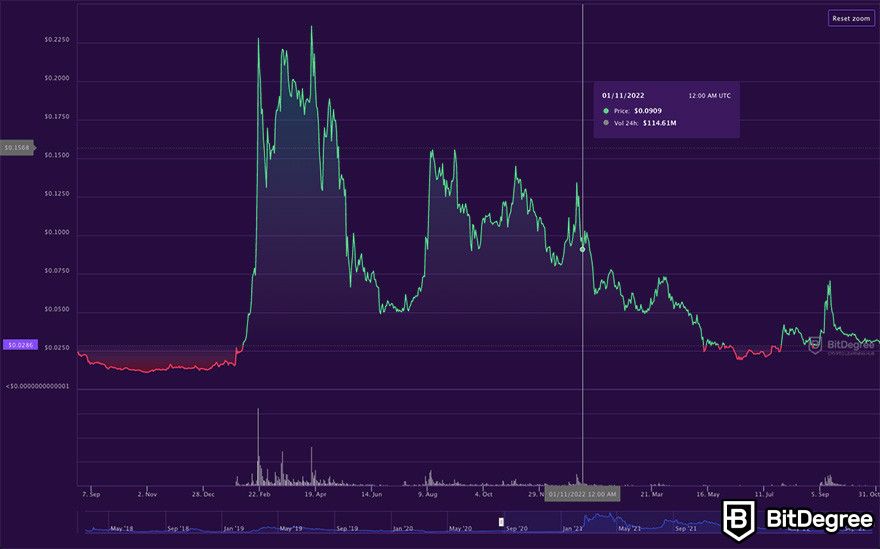
The line and green dot on the chart represent the day when the RVN halving took place. While it would be silly to draw any definitive conclusions out of a single halving event, we can still analyze how it impacted the overall price movement of the token.
Admittedly, the result probably wasn’t what the majority of token holders expected it to be! While Ravencoin did see a very small boost in price right after the halving, it quickly continued its downward trend, just like it has been doing for some time now – since August 2021.
While it may not have been the outcome that many have expected, it’s really not too surprising, either. The only crypto halving that tends to “set trends” on the market is that of Bitcoin - with it being the undisputed No. 1 cryptocurrency, it makes sense that whenever there’s a major event related to it, the market reacts as well.
Smaller projects, such as Ravencoin, simply don’t have enough leverage to sway the market trends in any significant way. Following that, if the general market sentiments are bearish (which they were during the time of the first RVN halving), then a sudden surge in price, all thanks to a halving event, isn’t exactly feasible either!
All of that being said, once again - all of this is a theory, and making bold statements and conclusions out of a single halving wouldn’t be the correct thing to do.
What are the Ravencoin Halving Price Predictions for 2026?
As I’ve pointed out in the previous chapter, while drawing specific conclusions regarding the effectiveness of the Ravencoin halvings isn’t exactly the smart thing to do just yet, enthusiasts of the project love to make price predictions nonetheless.
The one thing that’s worth pointing out, though, is that price predictions are very much tied to general market trends, as well as global news cycles. This is true with all cryptocurrencies, but especially with assets such as Ravencoin.
We’ve already covered the reason for why that’s the case, too - since the RVN coin isn’t exactly at the top of the popularity charts, its performance is often tied to those same general sentiments, and the performance of other, more prominent cryptos out there, such as the aforementioned Bitcoin and Ethereum.
Nevertheless, what are some price predictions for the Ravencoin halving of 2026?

Well, it will be the second halving that this project experiences, cutting the rewards from 2500 to 1250 RVN coins per block. Evaluating things in the most straightforward manner possible, this would mean fewer coins entering the market, and if the demand for RVN doesn’t change, it could influence a positive price movement.
2026, however, is a long time away. It’s impossible to say what the price of RVN is going to be when the next halving comes or how the entire crypto market will look. On top of that, the first halving was a good indication that cutting the mining rewards in half doesn’t always mean an automatic increase in the asset’s price, at least in the short term.
Whatever the case might be, it all boils down to how much you yourself, as a miner or investor, believe in the project. If you think that it’s part of the future of crypto, as a whole, chances are that you won’t be too bothered by short-term price fluctuations or things such as Ravencoin halvings not offering the outcome that you thought it would.
The Significance of Ravencoin Halvings
Before we wrap up talking about RVN halving, there’s one more big aspect that I’d like to cover - it has to do with the significance of said halvings as they pertain to the different groups of people in the crypto space.
Investors
If you’re an investor in Ravencoin, there’s a pretty good chance that you’ve already heard about crypto halvings. On top of that, our Ravencoin halving countdown tool is likely a page that you should bookmark, as well!
All of that is because investors are among the most impacted groups of individuals, halving phenomenon-wise. Since these events are specifically designed to cause changes in the price of the underlying asset (whether directly or indirectly), investors tend to watch the charts closely, even before the halving takes place.
As the very first RVN halving has shown, though, things aren’t always all that simple. Taking a single look at the chart that we discussed earlier in the text, you’ll notice that the halving correlated with a steady downward price trend, followed by what seems to be a period of stabilization.
All of that we’ve already covered earlier – that’s true. However, it’s really important to stress how unpredictable the crypto market can be! This, in turn, makes the job of an investor *that* much more difficult.
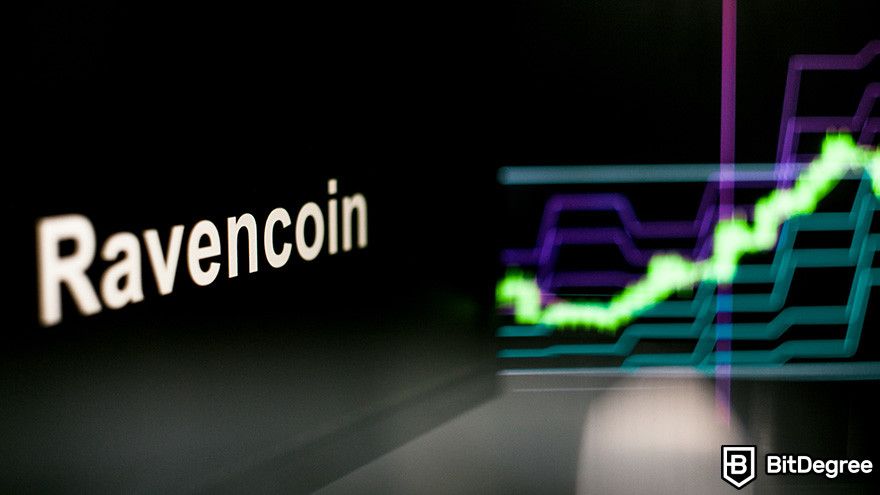
That being said, there are usually two big groups of people who invest in Ravencoin, and crypto, in general - day traders and long-term investors.
If you belong to the former group, then all of what I’ve said above is probably very relevant to you. Day traders try to catch the best prices every single day, since “buying low, selling high” is often their day job.
On the flip side, long-term investors are usually not too concerned with crypto halving events. Think about it yourself - if you’ve invested in Ravencoin and aren’t planning on touching that investment for the next few years, then the current halving doesn’t really make all that much of a difference, does it?
In short, while it all depends on perspective, as well as your position if you’re an investor in Ravencoin, halvings are still certainly something that you should be both aware of, as well as keep track of, too.
Miners
Crypto halvings are always a very interesting conundrum to miners of that specific cryptocurrency. The reason why that’s the case is, admittedly, quite self-explanatory.
If you mine, say, Ravencoin, it makes sense that you want to receive the highest amount of rewards possible. Truth be told, with RVN, this is even more so the case than with many other assets out there - this is due to the aforementioned ASIC resistance of Ravencoin as a network.
In that sense, Ravencoin halving dates should naturally be some of the worst days for miners since their rewards literally get halved. This, however, is mitigated by two factors - the fact that miners know about it right from the start of their mining ventures, as well as the concept of halvings theoretically boosting the price of the underlying asset.
I say theoretically since, as we’ve talked about earlier, that’s clearly not always the case – at least in the short term.
Similar to investors, there are basically two types of miners out there - those who focus exclusively on the financial gain that they’d receive from mining, and others who are also concerned with the underlying network - in other words, care about how it functions, participate in its development, and so on.
To the first group, Ravencoin halving events are quite scary since they bring along uncertainty and halved mining rewards. Thus, this group of miners is usually not too happy with the phenomenon.
The latter group, however, is a bit different. If you’re a miner who believes in the fundamentals of the project whose coin you are mining. In that case, you’d probably see halvings as necessary tools that help bolster the longevity and market stability of the entire project ecosystem. In short, though, it’s evident that miners as a group are rather split when it comes to RVN halving dates.
The General Crypto Community
Last but not least, what’s the impact of Ravencoin halvings on the rest of the crypto community - people who don’t hold or mine RVN coins and might not even be aware of the project, in general, but are still active participants in other projects, DeFi, Web 3.0, etc.?
Well, truth be told, there really isn’t much direct impact, to begin with! This is the case due to Ravencoin currently lacking the popularity of that seen by Bitcoin, Ethereum, Litecoin, and other similar crypto projects.
This, in turn, means that even some bigger events (such as the RVN halving) that happen within the project’s space don’t really influence any specific market movements - at least not in an immediately-notable sense.
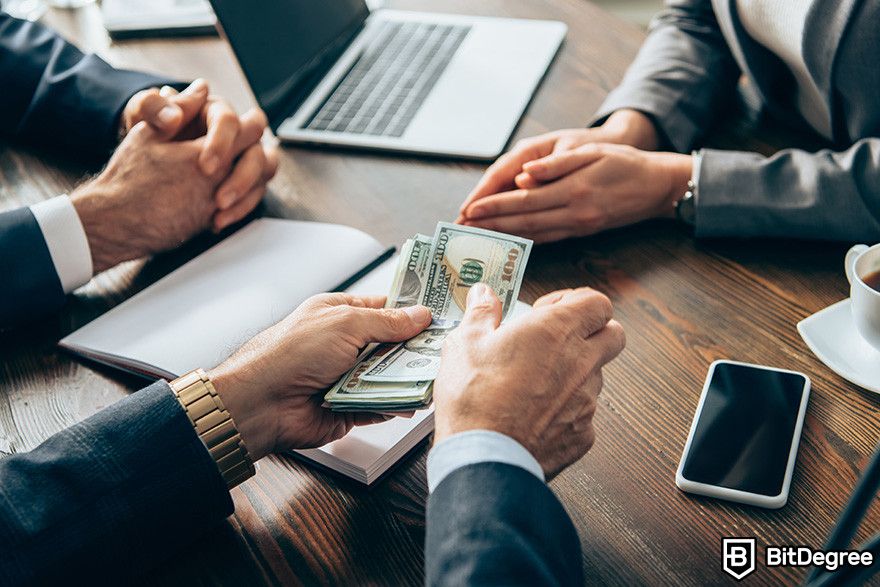
Why should the general crypto community be aware of the concept of Ravencoin halvings in the first place, then? Well, for starters, things add up - if, say, the halving coincided with some notable positive news regarding the general crypto space, this could mean a positive price movement of other related or similar assets as well.
On top of that, understanding Ravencoin halvings will also help you get a better idea of how halvings work in general - whether it be BTC halvings or even the super-convoluted Ethereum Triple Halving. Lastly, if you’re looking for a crypto asset to mine, understanding the intricacies of Ravencoin is an essential factor as well!
All in all, while the first Ravencoin halving didn’t cause any market-wide ripples, this does not mean that the project (as well as its underlying asset) won’t grow with time - who knows, perhaps the next halving will be extremely notable. Our Ravencoin halving countdown tool above will help you keep track of it!
Summary
With all of that being said, let’s have a quick summary of the most important points concerning the Ravencoin halving. If you’ve read the entire text up to this point, it’ll serve as a great refresher!
The key takeaways are:
- Ravencoin halving is a process where the RVN mining rewards are halved;
- It happens every 4 years (approx.), or every 2,100,000 blocks;
- Ravencoin is a fork of Bitcoin, and thus, the halving events of these two cryptocurrencies are similar;
- Ravencoin has only had a single halving on January 11, 2022, where the rewards for mining a block were cut from 5000 RVN to 2500 RVN;
- The purpose of the RVN halving is the same as with most other cryptocurrencies that employ this phenomenon - to bolster the asset’s deflationary features and cause synthetic price inflation.
If you keep all of the above points in mind, you should have a pretty good idea about Ravencoin mining and the key elements that surround it.
Conclusions
Whether you’re a miner, an investor, a crypto enthusiast, or anyone in between, analyzing Ravencoin halvings is a significant aspect of understanding the rest of the crypto space as a whole!
If you want to keep track of the next RVN halving event, make sure to bookmark this page and check out our countdown above!
